
In this article we cover the stories of two of the greatest heroes of Greek mythology, Herakles (known today mostly by the Roman form of his name, Hercules) and Theseus, the greatest hero of Athens.
There is in fact some overlapping between these two characters, for they are said to have known each other as friends, and participated in some adventures together.
Contents
Herakles is directly descended from the hero Perseus, one of the subjects covered in the Athena article. His story begins with Zeus mating with the beautiful Alcmena (the granddaughter of Perseus) while he was disguised as her husband Amphitryon.
Zeus' wife Hera was angry with his affair and made trouble for the child right from the time he was born. She sent two snakes to attack the baby while sleeping in his crib, but to everyone's surprise, little Herakles fearlessly grabbed the snakes and crushed them in his fists, displaying his courage and strength even as an infant.
The scene appears here in a red-figure vase painting, alongside his mortal twin brother Iphicles, who is terrified and clinging to his mother.

Red Figure
The same scene appears in the wall painting below, from Pompeii, along with a photograph of the room in which it is found, known as the house of the Vettii.

Pompeii

House of the Vettii
The painting by Tintoretto (1518-1594) depicts another story of an encounter between Hera and Herakles when he was a baby. Hera was deceived into breast-feeding him, and he bit down with his powerful teeth, injuring her breast. When she threw him down, he spewed a mouthful of milk, which is still visible today as the Milky Way in the sky.

The Origin of the Milky Way, Tintoretto
As an adult, Herakles was the strongest man of all time. He is depicted as a large, muscular man, usually bearded, and wearing his lion-skin garment. The first image is from the Classical period, one of the figures from the pediment of the Aphaia temple at Aegina (introduced in the Underworld article), with Herakles aiming a now-missing bow and arrow.

Pediments

Aphaia
The next image is a Hellenistic portrait statue known as the "Farnese Hercules", which shows his muscular body exaggerated to an almost ridiculous degree. The contrast between these two underscores the difference between the Classical and Hellenistic styles. In the Classical period, he is athletic, but not overly so, as was typical of the later Hellenistic.

Farnese Hercules
The painting following is one of the main panels of the 'Camerino', a portion of the Farnese Gallery by Anibale Carracci (1560-1609), known as "Hercules at the Crossroads," from 1596. It is more of an allegory than a myth, a scene using the hero Herakles as a symbol for everyone. As a young man, he came to a crossroads, uncertain which way to go. Two women appear and each tries to persuade him to follow her path. The one on the right is Pleasure, and on the left is Virtue, who points up a steep rocky path. Herakles had to decide between them, and chose Virtue, for even though her path was harder, the reward at the end would be immortality. Notice that Herakles lacks his beard and lion skin at this early point in his life, but can be recognized by his size and traditional club.

Hercules at the Crossroads - Carracci
The most famous part of the Herakles' career was his series of great undertakings known as the Twelve Labors. These tasks were actually a punishment for a tragic event in his life—he had a fit of insanity and lost control of his strength, killing his wife Megara and their children. But he was informed that by completing these tasks, he would not only atone for the murders, but also would earn immortality at the end of his life. Thus the story of the Twelve labors is also one of the conquest of death itself.
His first labor was slaying the Nemean lion, seen here in a red-figure vase painting. After killing the creature, he skinned it and made the pelt into a garment, seen being worn in most of the artwork which depicts him.

Nemean Lion
The second labor was the slaying of the Lernaean Hydra, a monstrous multiple-headed serpent, whose bite was extremely venemous. This has always been one of the most popular of the twelve labors in artwork, presumably because of the visual impact of the monstous Hydra is more interesting than an ordinary opponent. Here are three different artists' versions.
The first is by Antonio del Pollaiuolo (1429-1498), one of the most important artists of the early Renaissance. His interest in painting the human body led to an analytical approach, using corpses to better understand the anatomy in order to depict the human body more realistically.

Another artist of the later Renaissance, Rosso Fiorentino, made this glazed plate with the scene in 1570. Notice that he has included Herakles' assistant, his nephew Iolaus, using a torch to sear the stumps of the Hydra.

Hydra by Rosso
The final version is the painting by Moreau, now in the Art Institute of Chicago.

Moreau
Herakles' third labor was the capture (without killing) of the Cerynean Stag, a deer that was sacred to Artemis, seen here in a black-figure vase painting.

Deer
The fourth labor was the capture, again without killing, of the Erymanthian Boar. It is seen here in a black-figure vase painting (which looks to be by the same artist as the previous image), with Herakles using the boar to terrify Eurystheus, the king of Mycenae who is the one who assigns Herakles his tasks; Eurystheus is seen hiding in a giant jug, half-buried in the ground.

Capture of a Boar
The fifth labor was one of a different type altogether, for Eurystheus ordered him to clean out the stables of Augeas of Elis, something which had never been done before, so there were years of accumulated manure and filth. But Herakles came up with a clever solution to avoid doing this the hard way, for he simply carved a channel to redirect the course of a nearby river to flush the filth out. This is seen in one of the 12 metopes from the temple of Zeus at Olympia (seen previously in Prometheus and Athena). Here, Athena watches as Herakles performs his task.

Cleaning Out the Stables
The sixth labor was the slaying of the Stymphalian birds, animals which were said to be made of metal, whose beaks and wings were razor-edged. In this black-figure vase painting we see Herakles shooting at these birds with a type of sling.

Slaying Birds
The seventh labor was the capture of the Cretan bull (an animal we will learn more about in the article on Theseus, below) which is seen here in a recent photograph of another metope from Olympia. Do you recognize the sculpture in the background? It is one we looked at in Section 5.

Capture of a Bull
The eighth labor was the defeat of Diomedes, a wicked king of Thrace who owned a team of man-eating horses. After defeating him, Herakles decided that the most fitting punishment for Diomedes was to be fed to his own horses, the scene we see in this painting by Gustave Moreau. After they ate Diomedes, the spell was broken and they no longer wanted to eat people.

Diomedes Fed to Horses
Before the next labor, Herakles had one of his numerous lesser adventures, here the rescue of Alcestis, the wife of Admetus, an old friend of Herkales. During his travels, Herakles visited his friend and found that a tragedy had just occurred: Admetus had been granted a wish from the gods and got an extension of his allotted lifespan, but only if someone else gave up their life for him, which his wife Alcestis volunteered to do. But Herakles challenged the spirit of Death itself for the soul of Alcestis, and won. This struggle between Herakles and Death is seen in this dramatic painting by Frederick Leighton (1830-1896).

Alcestis
His ninth labor was rather unusual, for he was ordered to retrieve the girdle (or belt) of Hippolyta, the leader of the Amazons, a tribe of warrior-women who dwelled in the far east of the Black Sea. Although Herakles intended to negotiate peacefully for the girdle, Hera intervened and instigated a violent fight, during which Hippolyta was killed. The conflict is shown here in a black-figure vase painting, with Herakles fighting an Amazon labelled Andromache (the same name, but not the same character, as Andromache, the wife of Hector of Troy).

Amazons
The tenth labor carried Herakles to the most distant West, to retrieve the cattle of Geryon, a huge giant who had three bodies in one. This black figure vase painting shows Herakles aiming his arrow at the triple-body of Geryon, having already slain his ferocious dog.

Geryon 1
A second view of this reveals the whole scene in black and white. Visible in the background are Athena and the cattle he was seeking.
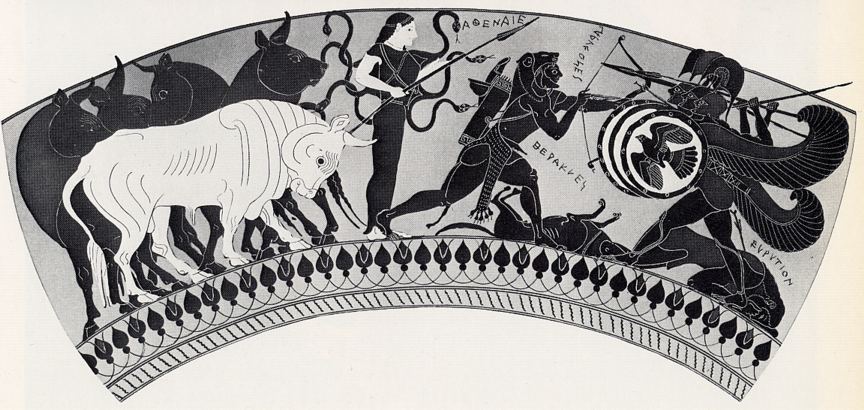
Geryon 2
The eleventh labor was to obtain the Golden Apples of the Hesperides, a group of goddesses who dwelled in a mystical garden in the furthest west, the land of eternal twilight (Hesperus means 'evening' in Greek). These apples, said to have been Zeus' wedding gift to Hera, were now protected by a monstous serpent named Ladon. The first image below is a portait of the Hesperides and the serpent by Frederick Leighton.
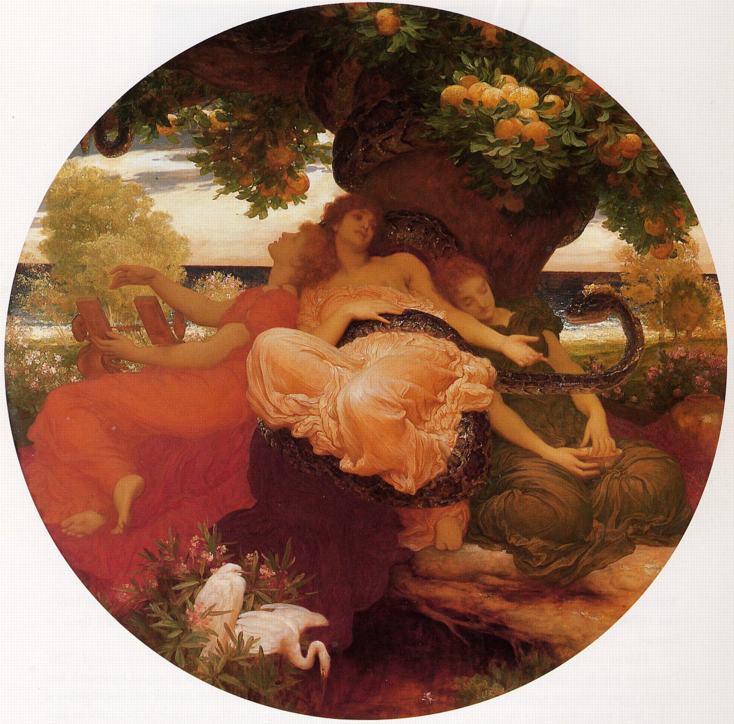
Hesperides
Some accounts say that Herakles battled and slew Ladon to obtain the apples, but another version of the story involves Atlas, who was said to be the father of the Hesperides. In that version, Herakles asked Atlas to retrieve the apples for him, which he agreed to do as long as Herakles was willing to substitute for him in his duty of holding up the sky (Herakles being the only human strong enough to do so). In another metope from Olympia, Herakles appears in the center, supporting the sky, with a lttle help from Athena, on the left. On the right, Atlas is returning with the basket of apples (now missing).

Atlas Metope
Before the final labor, Herakles had several lesser adventures, including his encounter with the giant Antaeus, who challenged anyone who wanted to go past him to a wrestling match. Herakles accepted the challenge, but became a little concerned when he realized Antaeus was getting stronger as they fought. But he realized the reason: As a giant, Antaeus gained strength from his mother, Gaea (Earth), as long as he was in contact with the ground. Herakles knew then the key to beating Antaeus was to lift him up, separating him from the earth, as seen in two versions by Pollaiuolo, a painting and a bronze sculpture.

Antaeus

Bronze
Another adventure before the last labor was the liberation of Prometheus, who was being punished by Zeus for stealing fire and giving it to humans (see article 3), until the day Herakles killed the bird which ate his liver daily. This is seen first here in a black figure vase painting, with Zeus and his bird on the left, Prometheus and Herakles on the right shooting an arrow.

Prometheus Black Figure
Another version of the liberation of Prometheus appears here by Christian Griepenkerl (1839-1916), late 1800s. For the twelfth and final labor, Eurystheus gave Herakles a task which he thought to be impossible—to bring the three-headed dog Cerberus up from the Underworld. Herakles accepted the challenge and descended, whereupon he encountered his friend Theseus, a living man who was trapped in the Underworld, stuck on a chair from which he could not get up. Herakles grabbed Theseus by the arm and ripped him from the magical chair, as seen in the red-figure vase painting below.

Griepenkerl
The liberation of Theseus appears in the Theseus portion of the following black figure vase.

Theseus
Herakles obtained permission from Hades to borrow Cerberus, and returned to the surface world with the monstrous dog In this black-figure vase painting, Herakles has once again startled Eurystheus, who has gone again to his giant jug to hide.

Cerberus
After the conclusion of the final labor, Herakles was on his own again, now having been guaranteed immortality at the end of his human lifespan. But before that, he had a few more noteworthy exploits. One involved a visit to the oracle of Delphi, as he was again seeking atonement, this time for the death of Iphitus, whom he had killed in a fit of rage. The oracle responded harshly to him, refusing to tell what his punishment would be, and Herakles became enraged and tried to snatch away the tripod on which the oracle sits (as seen in the Apollo article). The red-figure vase painting here shows Heracles in a 'tug-of-war' with the tripod against Apollo, the god of the oracle.
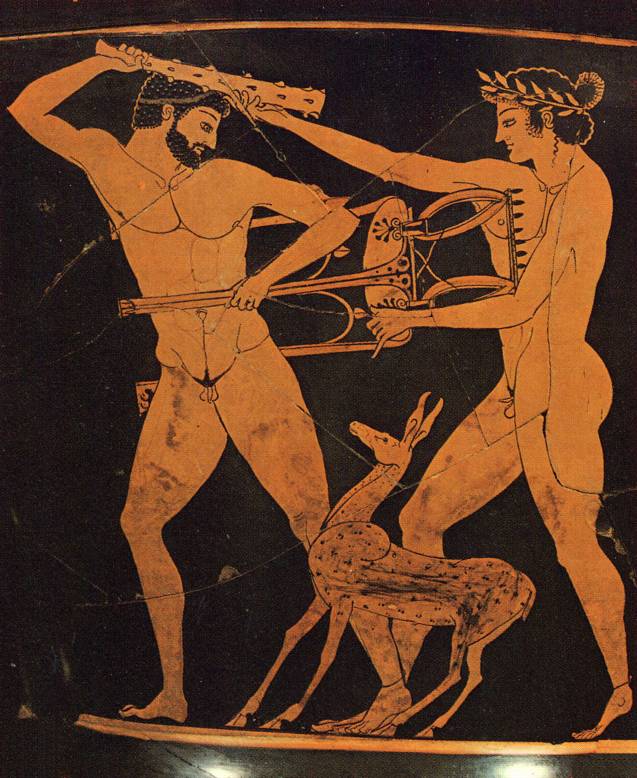
Delphi
Zeus then intervened to settle this dispute. After his two sons calmed down, Herakles released the tripod and was given his punishment—he must be the servant to a woman, Queen Omphale of Lydia, for a set period of time. What made their relationship unique is that it is said these two exchanged their clothes while he was with her, seen here in two paintings, the first by Bartholomeus Spranger (about 1600), and the other by Francois Lemoyne (1724).

Hercules and Omphale, Spranger

Hercules and Omphale, Lemoyne
After serving his time under Omphale, Herakles returned to Greece, and soon after married again. His new wife was named Deianeira from Aetolia, and for a time the two lived happily together. But one day an incident occurred which would eventually result in Herakles' death.

Black Figure
While the couple was travelling through the countryside, they came to a wide, rapid river, which would be very difficult for her to cross. But a centaur named Nessus happened by, who offered to carry her across the river on his back. Herakles then went across first, and turned to see that the centaur was trying to run away with his wife, instead of carrying her as he had agreed. Herakles quickly reacted by shooting Nessus from across the river with one of his poisoned arrows.

Pollaiuolo
The first image below is a very early black-figure vase painting which deviates from the story a little by showing him stabbing Nessus at close range. Pollaiuolo produced two versions of the scene see here, one a painting and the other a bronze sculpture (as he did with the Antaeus story above). The final version here shows the painting by Guido Reni. Note that Herakles is visible in the background.

Pollaiuolo Bronze

Reni
We have already looked at one of the key events in the story of Athens, namely the contest between Athena and Poseidon, which was won by Athena and hence the name Athens was given to it. In the red-figure vase painting here we see the mythical first king of Athens, Cecrops, shown with a snake's tail in place of legs to indicate that, like a snake (so the ancients believed), he was born directly from the earth.

Cecrops
The next king was Erecthonius, who was conceived in an unusal manner. Hephaestus was lusting after Athena, who as a virgin goddess wanted no part of that, but he ejaculated upon her leg. She threw the sperm to the ground (mother Earth) and a child was born. Athena felt some responsibilty for the child so she became his foster mother. The painting here by Bordone shows Hephaestus going after Athena, who repulses him.

Bordone
The red-figure vase painting shows the child Erecthonius being handed by Gaea (Earth) to Athena while Hephaestus watches.

Erechtheonius
Several generations later, a descendant of the early kings named Aegeus fathered a son with Aethra, the daughter of Pittheus, the ruler of Troezen. Aegeus returned to Athens after giving Aethra instructions for his son, once she determined he was old enough and strong enough, to lift a huge boulder under which Aegeus had deposited a sword and a pair of sandals.
The first image here is a terracotta relief showing Aethra pointing to these items as Theseus lifts the rock, seen also in the painting by Poussin. Now Theseus was ready to go to Athens and find his father, but along the way he had a series of encounters, sometimes known as the "labors of Theseus," obviously patterned after the adventures of the more famous hero, Herakles.

Aethra

Theseus Recovering His Father's Sword, Poussin c. 1638
This red-figure vase painting shows a total of six separate scenes with Theseus on these labors, and his defeat of the Minotaur in the center.
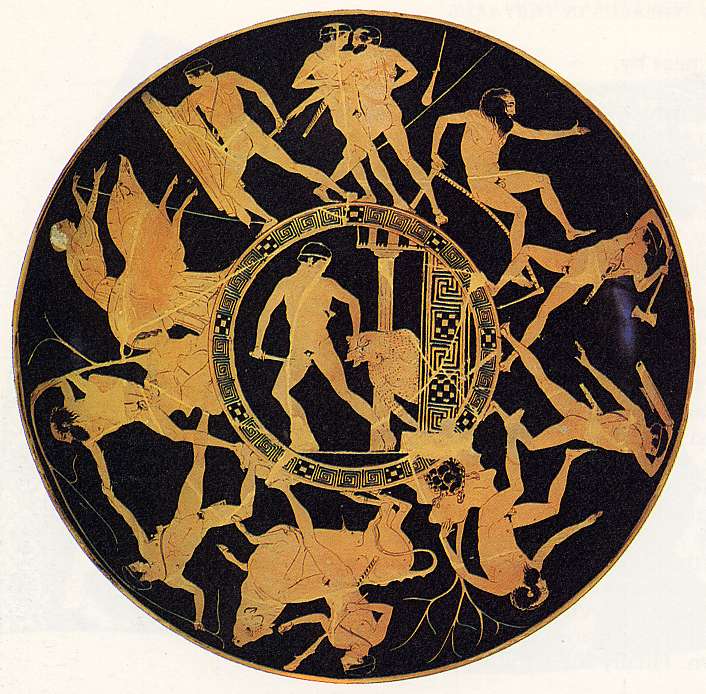
Theseus' Six Labors, Red Figure
One of the minor adventures included in this is a scene by itself in the black-figure vase painting, Theseus' capture of the bull of Marathon (a city close to Athens). This was the same bull that Herakles had brought over from Crete as his seventh labor, and was now causing trouble until Theseus captured and sacrificed it.
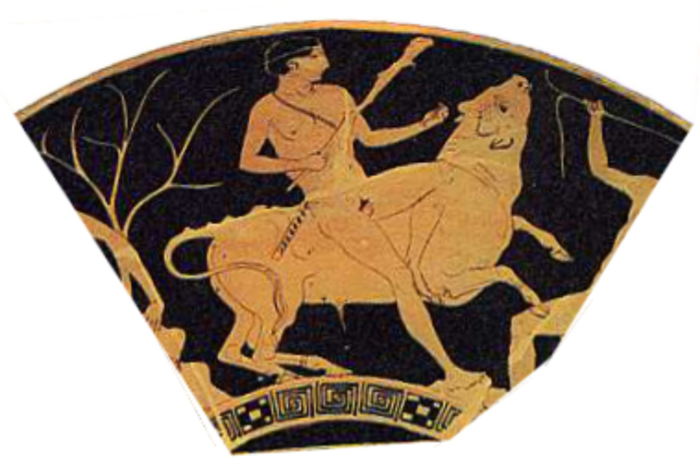
Capturing Bull of Marathon, (Rotated)
After Theseus arrived at Athens and met his father, he learned of the annual sacrifice made by the Athenians, who are forced to send seven boys and seven girls to be victims of the Minotaur on the island of Crete, a punishment inflicted upon them by king Minos. However, before relating Theseus' fight with the Minotaur, we will first learn how this strange creature came to be born.

Theseus Subdues the Marathon Bull
The story begins in the Near East, in the land known as Phoenicia (modern day Lebanon), where the king, Agenor, had a beautiful daughter named Europa. Zeus was attracted to her and came to earth in the form of a bull, which she did not suspect was Zeus. After coaxing her into climbing onto his back, Zeus swam away with her, eventually bringing her to the island of Crete, where she gave birth to the future king, Minos.
The abduction of Europa is seen here in four different versions. First, an Archaic metope (notice the fish below to make it clear this bull is crossing the sea), then a wall painting from Pompeii, followed by a dramatic version by Titian, and lastly one by d'Arpino.

Metope

Pompeii Wall Painting
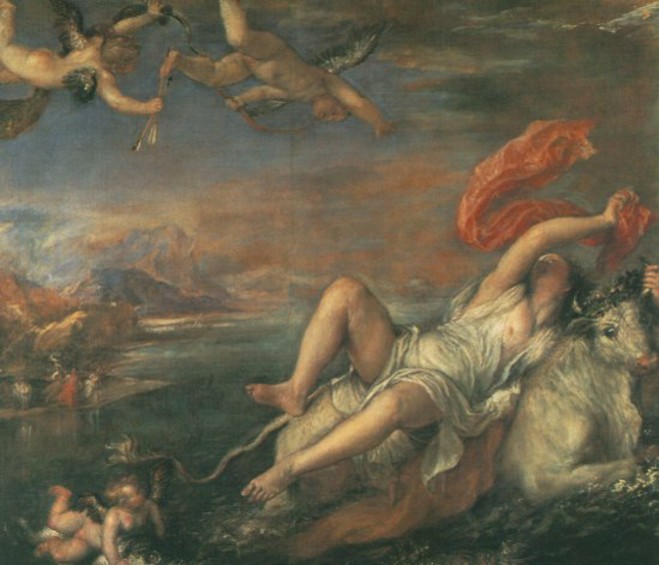
Titian

d'Arpino
After Minos grew up, he married a woman named Pasiphae. Minos then angered the gods by failing to sacrifice a special bull given to him from Poseidon, and the punishment was bizarre—his wife Pasiphae was driven mad with an insatiable lust for the bull. Minos turned this strange task over to his great craftsman Daedalus, who is seen here in another Pompeiian wall painting presenting Pasiphae with a hollow cow into which she can be enclosed in order to mate with the bull.

Pompeii
The result of this strange union was a creature that was half-bull, half-human, called the Minotaur (the Minos-bull), seen in a portrait by George Frederick Watts from the late 1800s.

The Minotaur - Watts
The next picture is an ancient wall-painting from the palace of Knossos, the real-life location of the story of the Minotaur, showing some acrobats engaged in 'bull-leaping', somersaulting over the animal. This artifact and others demonstrate that the bull was a very important symbol to these people, and it is a recurrent image throughout the myth.

Knossos Acrobats Bull-Leaping Sport
The myth goes on to say that Daedalus then designed a huge maze-like structure, known as the Labyrinth, to contain the monster. The Labyrinth is seen here in a mosaic from a Roman city of North Africa.

Labyrinth Mosaic
When Theseus went along with the latest victims, he received invaluable help from Ariadne, the daughter of Minos, who had fallen in love with Theseus at first sight. She gave him the secret of escaping the Labyrinth, depicted here in a sketch by Burne-Jones as a simple ball of string which he unrolls going in, and can then follow to find the way out.

Theseus and the Minotaur in the Labyrinth, Burne-Jones
When the Minotaur emerged to take its latest victims, Theseus killed the monster with his sword, seen here in a vivid black-figure vase painting.

Black Figure
Next, two works from Pompeii,the first a mosaic with the two figures wrestling, and then in a well-preserved wall painting with the Minotaur already dead while Theseus is being thanked by the recscued victims.
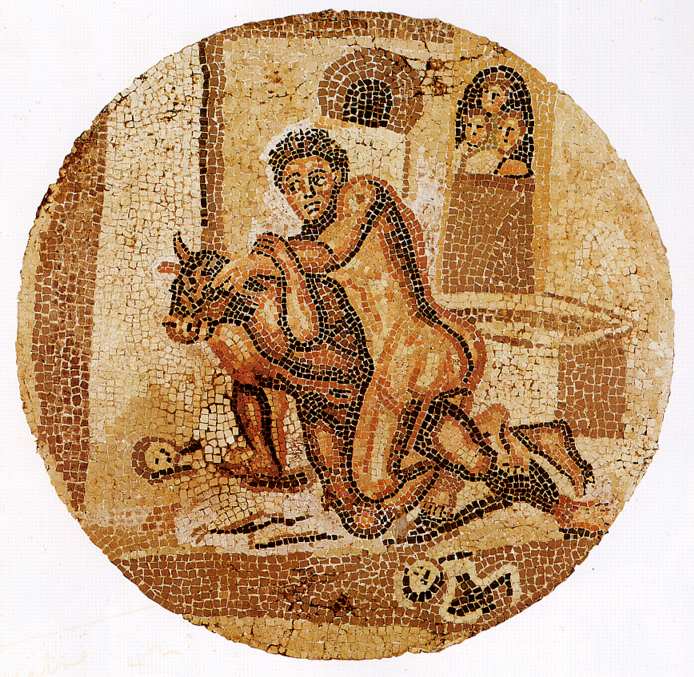
Pompeii 1

Pompeii 2
After helping Theseus escape the Labyrinth, Ariadne fled with him on his return trip to Athens. But halfway home they stopped on the island of Naxos to spend the night. When Theseus departed the next morning, he neglected to take Ariadne with him. She awoke to find herself alone and abandoned by the man she had loved, as seen in this wall painting from Pompeii.

Pompeii
But immediately after that, the god Dionysus approached Ariadne to explain that the gods fogged Theseus' mind to forget about her because it was her destiny to be his wife and become a goddess herself. This scene is depicted here by the two great artists of Venice, Titian and Tintoretto. Titian shows the arrival of Dionysus (or Bacchus) with all his followers, the satyrs and maenads, while Tintoretto has just one other figure, namely Aphrodite, hovering in between joining their hands in love. Notice that both artists have included a crown of stars, a reference to a particular constellation associated with Ariadne.

Titian

Tintoretto
After Theseus returned to Athens from Crete, he inherited the throne, for his father Aegues had committed suicide when he mistakenly thought that Theseus had failed. During the time he was king, Theseus was involved in a battle with the Amazons, the warrior-women whom Herakles had fought during one of his labors. Theseus fell in love with one of the Amazons and took her back home as his bride, as depicted in the scene on this red-figure vase.

Amazon
They had a son named Hippolytus, but soon after his birth his mother died during a counterattack of the Amazons. Theseus remarried after that, and his new wife was Phaedra, another daughter of Minos. When Hippolytus had grown up, he swore absolute devotion to Artemis, the virgin huntress. This angered Aphrodite, who then punished Hippolytus by causing Phaedra, his stepmother, to try to seduce him. When Hippolytus refused her advances, Phaedra committed suicide out of shame. However, she left a message for Theseus that she had done so because Hippolytus had tried to assault her. Theseus believed this lie and called down a curse upon his son, which resulted in Hippolytus' death.
The scene is shown in a painting by Rubens, with a monstrous sea creature terrifying Hippolytus' horses so that he is thrown from the chariot. Fatally wounded, Hippolytus tells his father what really happened between him and Phaedra.

Rubens
One final story about Theseus was previously mentioned above—his rescue from the Underworld by Herakles. Theseus had been trapped there for some time after having been apprehended with his friend Pirithous when they tried to steal Persephone away from Hades. As we learned, Herakles pulled him free from the chair and he returned to the surface to live out his remaining lifetime.

Herakles
Certainly one of the best-known Greek myths, this story relates how Daedalus, the craftsman/inventor who designed the Labyrinth for Minos, wished to leave Crete but was forbidden by Minos, who ordered that no ship leaving the island was to take Daedalus away. But Daedalus used his skills to invent a way to escape—a set of wings which could make a person fly like a bird. He made a pair for himself and another for his son Icarus, and warned him about flying too high, since this would bring him near to the sun whose warmth would melt the wax that held the wings together. But Icarus ignored his father's warning and did fly too high, and his wings fell apart, and he plummeted to his death in the sea below.
This is seen here first in a romanticized painting by Herbert Draper.

The Lament For Icarus, Draper (1898)
The fall is portrayed in a very different way by Baroque artist Pieter Bruegel the elder. "Landscape With the Fall of Icarus" is the title, but you must look very closely to find Icarus, as only a glimpse of his leg appears, splashing into the sea. Bruegel is clearly making a statement here, that Icarus was in the end very insignificant in the grand scheme of things.

Landscape With the Fall of Icarus, Bruegel (c. 1560)